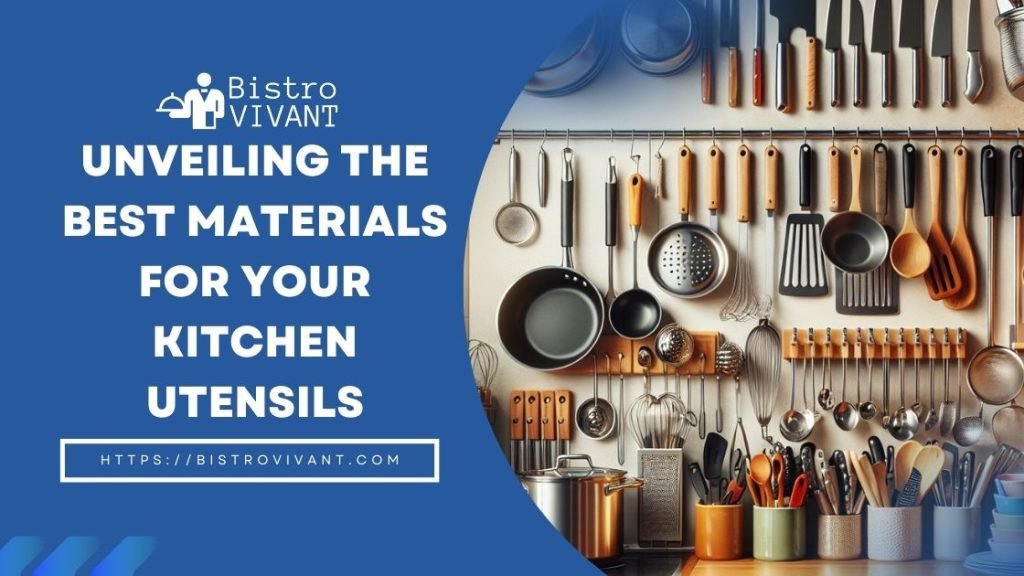Cooking utensils play a crucial role in our daily culinary endeavors, and selecting the best material for cooking utensils is paramount to achieving optimal cooking results. The choice of utensil material not only affects the taste and texture of your dishes but also influences their longevity and your overall cooking experience. In this introduction, we will discuss the importance of choosing utensil materials and the main varieties used in kitchens globally.
When it comes to cooking utensil materials, several options are available, each with its own unique characteristics and benefits. The choice between stainless steel, wood, silicone, and others can significantly impact the quality of your cooking.
This article will explore the properties of these materials, helping you make informed choices when stocking your kitchen. Whether you’re a professional chef or a home cook, understanding the merits of different utensil materials is essential for elevating your culinary endeavors.
Stainless Steel Utensils
Stainless steel utensils have gained immense popularity in the world of cooking due to their unique set of advantages and disadvantages. Understanding their properties and ideal use cases can help you make informed decisions when selecting kitchen utensils.
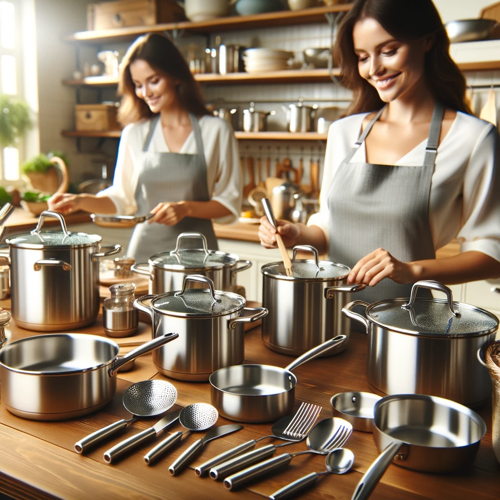
Advantages of Stainless Steel Utensils
Stainless steel utensils are renowned for their durability, making them a long-lasting investment for your kitchen. They exhibit excellent resistance to high temperatures, which is essential for cooking a wide range of dishes. Additionally, these utensils are incredibly easy to clean, saving you precious time and effort in the kitchen.
Disadvantages of Stainless Steel Utensils
One drawback to keep in mind is their heat conduction properties. While stainless steel utensils are excellent at withstanding high temperatures, they can become hot to the touch during cooking. It’s important to use oven mitts or handles to avoid burns. Moreover, stainless steel utensils have the potential to scratch non-stick surfaces, so caution is advised when using them with delicate cookware.
Ideal Use Cases for Stainless Steel Utensils
Stainless steel utensils shine in scenarios where durability and heat resistance are crucial. They are ideal for tasks like searing, browning, and deglazing. These utensils are also well-suited for use in ovens and grills due to their high temperature tolerance. However, it’s best to avoid using them with nonstick cookware to preserve the integrity of your non-stick surfaces.
Wooden Utensils
Wooden utensils have long been a favorite choice in the world of cooking, and for good reason. They offer a unique blend of advantages and disadvantages that cater to specific kitchen needs.
Advantages of Wooden Utensils
Wooden utensils are prized for their non-conductive nature, making them ideal for use with various cookware, including non-stick surfaces. This characteristic ensures that they won’t scratch or damage your pots and pans. Additionally, wooden utensils are renowned for their aesthetic appeal, adding a touch of natural beauty to your kitchen.
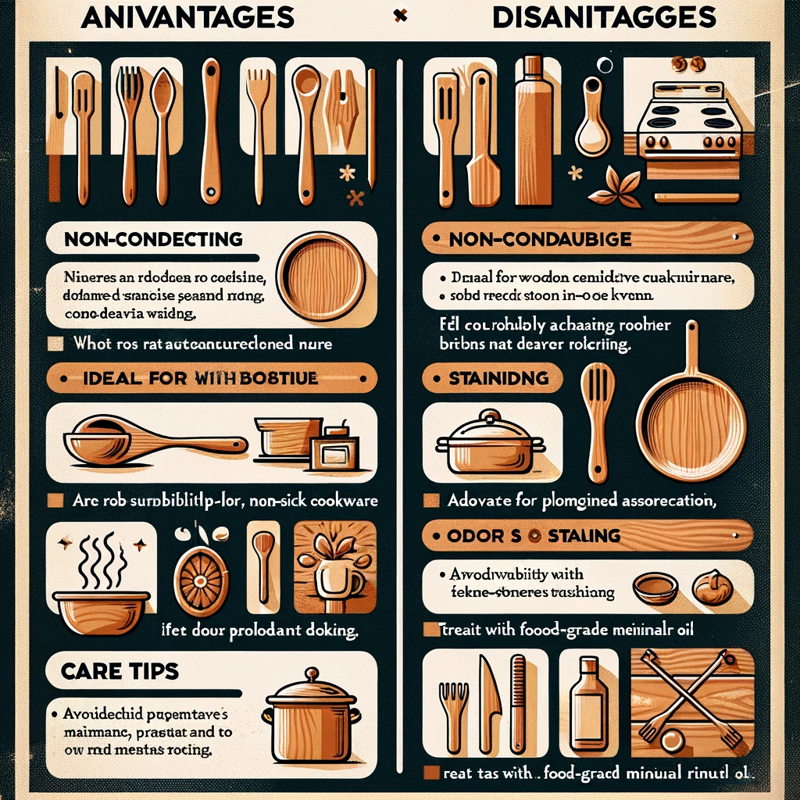
Disadvantages of Wooden Utensils
However, wooden utensils do come with their share of drawbacks. They are susceptible to staining and can absorb odors from certain foods. This means that you may need to put in a bit more effort to keep them looking and smelling fresh. Wooden utensils also require regular maintenance to ensure their longevity.
Tips for Caring for Wooden Utensils
To keep your wooden utensils in top-notch condition, it’s essential to wash them by hand with mild soap and warm water. Avoid soaking them for extended periods, as excessive moisture can lead to damage. Periodically, treat your wooden utensils with food-grade mineral oil to maintain their luster and prevent them from drying out.
Silicone Utensils
Silicone utensils have become increasingly popular in the kitchen due to their unique advantages. These utensils are known for their heat resistance, flexibility, non-scratch properties, and the availability of a variety of colors. These features make them a versatile choice for various cooking tasks.
Advantages of Silicone
Heat Resistance: Silicone utensils can withstand high temperatures, making them ideal for cooking methods that involve heat, such as frying and baking. They won’t melt or warp even under extreme heat.
Flexibility: The flexibility of silicone utensils allows for easy maneuvering in pots and pans. This flexibility ensures that you can efficiently scrape every bit of food from the cooking surface.
Non-Scratch: Silicone utensils are gentle on cookware surfaces, including non-stick pans. You won’t have to worry about scratches or damage to your cookware.
Variety of Colors: Silicone utensils come in a wide range of colors, allowing you to match them with your kitchen decor or simply add a pop of color to your utensil collection.
![]()
Disadvantages of Silicone Utensils
While silicone utensils offer many advantages, they are not without their drawbacks. They are not as durable as metal utensils and may wear out over time with heavy use. Additionally, silicone can retain odors, which may affect the taste of certain dishes if not cleaned thoroughly.
Situations Where Silicone Utensils Shine
Silicone utensils are an excellent choice for everyday cooking tasks, especially when using non-stick cookware. They are perfect for flipping pancakes, stirring sauces, and sautéing vegetables. Their heat resistance also makes them suitable for high-temperature cooking methods. However, for tasks that require heavy-duty or prolonged use, such as chopping or cutting, traditional metal utensils may be a better choice due to their durability.
Other Materials: Bamboo, Plastic, Teflon, and More
In addition to the commonly discussed materials like stainless steel and cast iron, there are several other materials used for cooking utensils. Each of these materials has its own set of advantages and disadvantages, making them suitable for specific cooking tasks.
Bamboo
Bamboo utensils have gained popularity due to their eco-friendly nature. They are lightweight, heat-resistant, and gentle on cookware. However, they can splinter and may not be as durable as metal alternatives.
Plastic
Plastic utensils are affordable and come in various shapes and sizes. They are lightweight and safe for non-stick cookware. However, they can melt at high temperatures and may not be as long-lasting as other options.
Teflon
Teflon-coated utensils have nonstick coatings that make cooking and cleaning a breeze. They are perfect for delicate foods. However, Teflon can wear off over time, potentially releasing harmful chemicals.
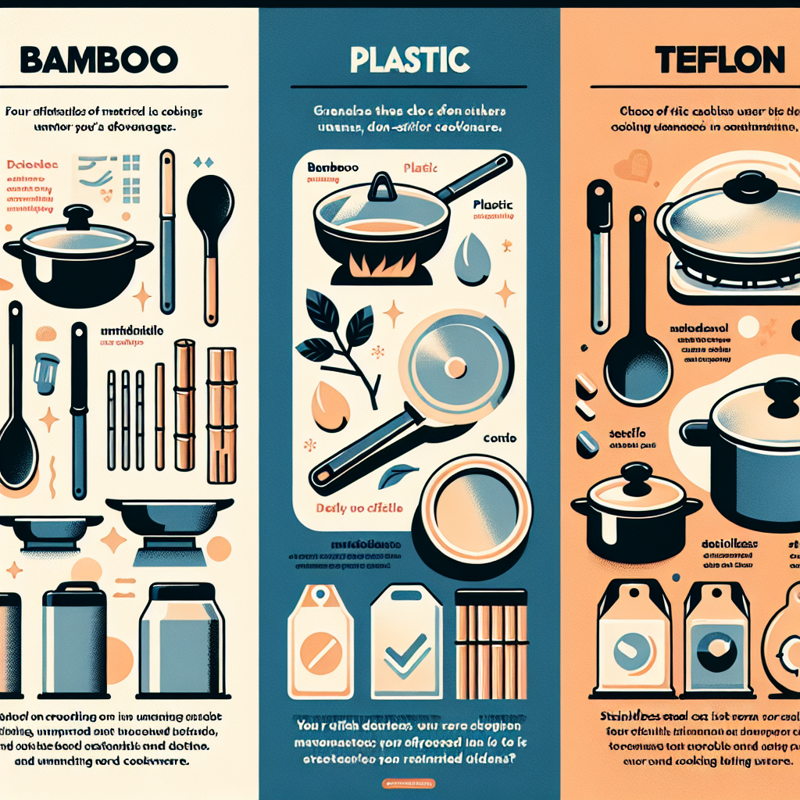
When comparing these materials to traditional choices, it’s important to consider their specific uses and limitations. While bamboo is great for serving, plastic is suitable for light tasks, and Teflon is excellent for low-fat cooking, none of them can fully replace the versatility and durability of stainless steel or cast iron. Therefore, the best material for cooking utensils ultimately depends on your cooking style and preferences.
Factors to Consider When Choosing Utensil Material
When it comes to selecting the common cookware materials, several factors should influence your decision. These factors revolve around your cooking style, maintenance preferences, and health considerations.
Cooking Style and Requirements
Your cooking style plays a crucial role in determining the ideal utensil material. If you frequently engage in high-heat cooking techniques such as searing or stir-frying, opt for materials like stainless steel or cast iron, known for their heat resistance. Conversely, if you often work with delicate surfaces like non-stick cookware, choose utensils with materials that won’t scratch or damage the surface.
Maintenance and Longevity
Consider how much effort you’re willing to invest in utensil maintenance. Stainless steel and silicone are low-maintenance options, requiring minimal care. On the other hand, wooden utensils add a touch of elegance but need more regular oiling to prevent drying and cracking.
Health and Safety Considerations
The safety of your cookware matters, especially when it comes to materials that may leach harmful chemicals or trigger allergies. Look for utensils made from food-grade, non-reactive materials such as stainless steel, silicone, or heat-resistant nylon. Avoid materials like aluminum, which can react with certain foods, and be mindful of any allergenic materials.
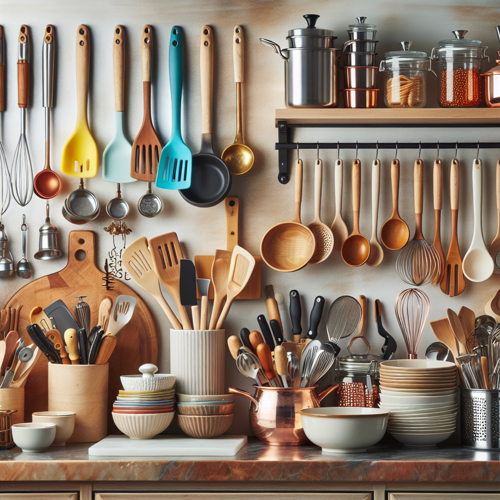
Impact of Different Materials
When it comes to choosing the best material for cooking utensils, it’s essential to consider not only their functionality but also their environmental impact. Sustainability is a growing concern in today’s world, and your preferred material can play a significant role in reducing your carbon footprint.
Bamboo and wood have gained popularity as eco-friendly alternatives for cooking utensils. These natural materials are renewable and biodegradable, making them a sustainable choice. Bamboo, in particular, grows rapidly and requires minimal resources to cultivate. Wooden utensils, when sourced responsibly, can also be an environmentally conscious option.
On the other hand, there are significant environmental concerns with plastic utensils. Most plastic utensils are made from non-renewable fossil fuels, and their production contributes to pollution and greenhouse gas emissions. Additionally, plastic utensils are not biodegradable and can persist in the environment for hundreds of years, causing harm to ecosystems.
Conclusion
The choice of the best material for cooking utensils plays a crucial role in ensuring the quality and safety of your cooking experience. When considering materials, it’s essential to prioritize factors such as durability, heat resistance, and food safety. While various materials like stainless steel, cast iron, and silicone offer unique advantages, it’s vital to select the one that aligns with your cooking needs and preferences.
Whether you’re looking for the perfect sear on a steak or non-stick convenience, the right choice of material can enhance your culinary adventures. Remember to care for your utensils properly to prolong their lifespan, and always prioritize your cooking safety and enjoyment.
FAQs
Q1: What are the top 10 essential kitchen tools every cook should own?
Ans: Every cook’s kitchen should be equipped with essential tools to make food preparation efficient and enjoyable. Here are the top 10 kitchen tools every cook should own:
- Chef’s Knife: A versatile cutting tool for chopping, slicing, and mincing.
- Cutting Board: Preferably one each for raw meats and vegetables to prevent cross-contamination.
- Measuring cups and spoons is essential for following recipes accurately.
- Mixing Bowls: A set of varying sizes for mixing ingredients.
- Spatula: both a flipper type for turning foods and a silicone one for scraping bowls.
- Whisk: for beating eggs, whipping cream, and blending ingredients smoothly.
- Vegetable Peeler: For peeling and slicing vegetables and fruits.
- Can Opener: A must-have for opening canned ingredients safely.
- Tongs are versatile for flipping meats, tossing salads, and serving.
- Saucepans and Skillets: A small and large skillet and a set of saucepans for various cooking tasks, from frying to simmering.
These tools form the foundation of a well-equipped kitchen, enabling cooks to handle a wide range of recipes and cooking techniques efficiently.
Q2: What is the difference between kitchen utensils and cutlery?
Ans: Kitchen utensils and cutlery serve different purposes in the kitchen and dining area. Kitchen utensils refer to tools used in the preparation of food, including items such as spatulas, whisks, ladles, and tongs. These tools assist in the cooking, baking, mixing, and measuring processes.
On the other hand, cutlery typically refers to handheld tools used for eating, such as knives, forks, and spoons. Cutlery can also include serving pieces and specialty items like steak knives. While kitchen utensils are primarily focused on food preparation, cutlery is centered around the serving and consumption of food.
Q3: Can kitchen utensils be recycled?
Ans: Many kitchen utensils, especially those made of metal or plastic, can be recycled, depending on your local recycling guidelines. Before recycling, it’s important to clean them thoroughly. However, some recycling programs may not accept mixed-material, extremely filthy, or damaged cutlery.
Q4: How often should I replace my kitchen utensils?
Ans: The lifespan of kitchen utensils depends on their material, quality, and how well they are maintained. Items like knives may last many years with proper care and regular sharpening, whereas plastic utensils may need to be replaced more frequently due to wear and tear. Inspect utensils regularly for signs of damage or wear and replace them as needed to ensure safety and efficiency in the kitchen.
Q5: What’s the difference between a spatula and a turner?
Ans: A spatula is a broad term that can refer to various kitchen tools used for flipping, spreading, or scraping. In contrast, a turner specifically refers to a type of spatula with a flat, thin blade designed for sliding under food to flip or lift it from cooking surfaces. Turners are often made of metal or plastic and are shaped to easily maneuver under pancakes, burgers, and other foods.
Q6: Are there any kitchen utensils specifically designed for left-handed people?
Ans: Yes, there are kitchen utensils specifically designed for left-handed people, including can openers, peelers, and knives with ergonomic handles and blades aligned for left-handed use. These tools are designed to provide comfort and efficiency for left-handed users, making kitchen tasks easier and safer.
 https://bistrovivant.com is a participant in the Amazon Services LLC Associates Program, an affiliate advertising program designed to provide a means for website owners to earn advertising fees by advertising and linking to Amazon (.com,.co.uk,.ca, etc.) and any other website that may be affiliated with the Amazon Service LLC Associates Program. As an Amazon Associate, I earn from qualifying purchases.
https://bistrovivant.com is a participant in the Amazon Services LLC Associates Program, an affiliate advertising program designed to provide a means for website owners to earn advertising fees by advertising and linking to Amazon (.com,.co.uk,.ca, etc.) and any other website that may be affiliated with the Amazon Service LLC Associates Program. As an Amazon Associate, I earn from qualifying purchases.

